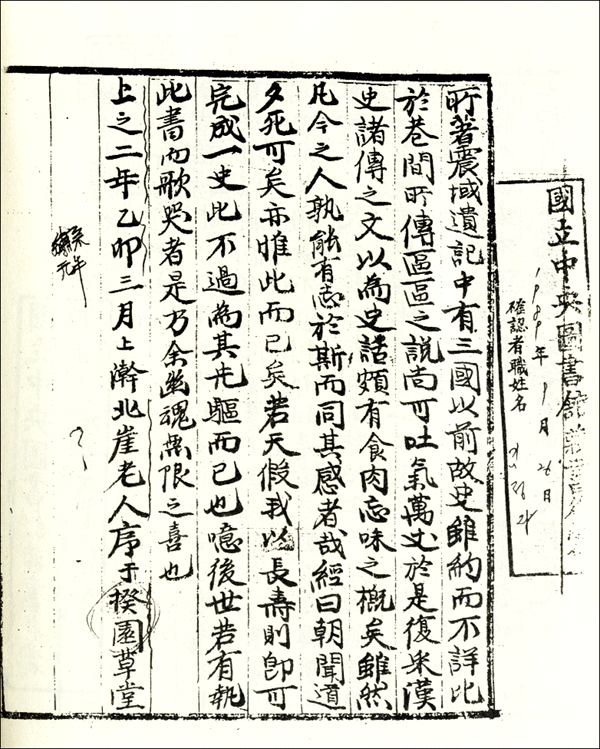- Gyuwon Sahwa
hangul=규원사화
hanja=揆園史話
rr=Gyuwon sahwa
mr=Kyuwon sahwa
The "Gyuwon Sahwa"(규원사화) is a text which describes ancientKorea n history including the creation of the universe, and is considered to be written in 1675 or before 1925.The name of this book was first mentioned in 'Danjeon Youi(단전요의, 檀典要義)' which was published in 1925, and introduced a part of the contents.A copy of the transcription, which Dr. Yang Judong collected before 1940, was first published in 1968. However, the book which is believed to be transcibed in
Joseon Dynasty era and is now kept in theNational Library of Korea , was discovered, and authenticated by its Ancient Texts Examination Committee in 1972.In Gyuwon Sahwa, the author calls himself "
Buk-ae ja" (북애자/北崖子) or "old man Buk-ae" (北崖老人), which can be a Buddhist title. The book states that it is based on "Jinyeok Yugi " (진역유기, 震域遺記), which was written by Yi Myeong(이명, 李茗), and no longer exists. Several of the China's mythical rulers are mentioned, although slightly different in detail from the Chinese "Sagi".Today, its principal value is generally seen in its role as a historical story reflecting the consciousness of the period, rather than as a historical record. [cite web|url=http://100.nate.com/EnSrch.asp?kid=11374300|title=규원사화|work=Pascal Encyclopedia|accessdate=2006-11-12, see also cite web|url=http://100.empas.com/dicsearch/pentry.html?s=B&i=117008&v=43|title=규원사화|work=Korean Britannica|accessdate=2006-11-12] Similar contents are also found in "
Hwandan Gogi ", which is generally believed to have been influenced by the "Gyuwon Sahwa" [cite web|url=http://100.empas.com/dicsearch/pentry.html?s=B&i=117008&v=43|title=규원사화|work=Korean Britannica|accessdate=2006-11-12] .In the conference of "Cooperative Conference about Dangun and Gojoseon by North and South Korean Historians" held in 2002 [단군 및 고조선 관계 비사들에 대한 이해 (규원사화를 중심으로) (About the Historical Records of Dangun and Gojoseon: focusing on Gyuwon Sahwa), 단군 및 고조선에 대한 역사학자들의 공동 학술토론회(Cooperative Conference about Dangun and Gojoseon by North and South Korean Historians), 평양인민문화궁전, October 3rd, 2002] , Professor Son Jongyeong concluded that Gyuwon Sahwa is a real historical record of Gojoseon and is worthy of research. Additionally, the chronicle of Danguns from the 1st Dangun to the 47th Dangun described in Gyuwon Sahwa are cited in the book titled Gojoseon Ryeoksa Gaegwan(The Outline of Gojoseon History published in North Korea) [허종호, 고조선력사 개관, 사회과학출판사 (2001)] .
Contents
The book consists of five parts: Prologue(揆園史話序), Jopan-gi(肇判記), Taesigi(太始記), Dangun-gi(檀君記), and Epilogue(漫說).
* The Prologue and Epilogue consist of the author's comments. The author states that the contents are based on Yi Myeong's "
Jinyeok Yugi " (진역유기, 震域遺記), a lateGoryeo dynasty text which in turn is based on "Jodaegi ", aBalhae history text. Neither survives today, but "Jodaegi" is mentioned inAnnals of Joseon Dynasty of King Sejo era.
* "Jopan-gi" describesHwan-in ,Hwanung and the division of heaven and earth and the origins of life and humans;
* "Taesigi" describes the rule of shinshi(神市氏) and other legendary god-like sages who ruled over humanity for 11,000 years. In addition, semi-legedary rulerChiwoo is described to have defeated ChineseYellow Emperor .
* "Dangun-gi" describes theDangun Joseon (also 'Danguk' or 'Baedalguk') which lasted 1205 years and was ruled by several "Imgeum" (kings). 'Dangun' means the king of Dan-nation. 'Imgeum' was used as the title name of rulers in Gyuwon Sahwa.Notes
ee also
*
History of Korea
*Korean mythology
*Budoji
*Hwandan Gogi
*Gojoseon
*List of Korea-related topics Link
* 한영우, 17世紀의 反尊華的道家史學의 成長―北崖子의 揆園史話에 대하여―, 한국학보 1, 1975
* 이상시, [http://web.edunet4u.net/~lost/lost/select3/3-13.htm] 규원사화에 대하여
* 김정배, 한국사 권4 - 초기국가 – 고조선.부여.삼한, pp.53, National Institute of Korean History 국사편찬위원회, 1997.
*EncyKorea 한국민족문화대백과사전 - 규원사화, The Academy of Korean Studies 한국학중앙연구원, 1991 ~ 1996
Wikimedia Foundation. 2010.

